|
Even
the world’s biggest and most established
cities had to start somewhere and the
earliest hubs for places like New York,
London and Sydney can be traced to the
natural water inlets which continue to be
very much at the heart of those cities
today.
Dubai is no different and
the bustling Creek, which slices through
the centre of the city, has become one
of the best-known waterways in the
world.
Since earliest times, Dubai
has been a meeting place, bringing
together the Bedouin of the desert
interior with the pearl diver, the
merchant of the city with the sea-going
fisherman.
The Creek is the natural
seawater inlet, which is the historic
focal point of life in Dubai.
While skyscrapers and
billion dollar developments have kept
Dubai on the move over the last 20 years,
a stroll along the banks of the Creek will
evoke memories of the city’s centuries-old
trading traditions.
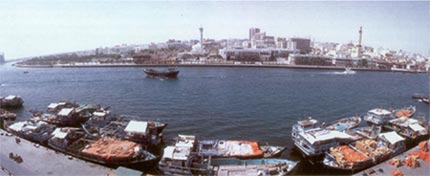
Under the shadows of state-of-the-art skyscrapers,
the banks of the Creek are a hive of
colour and bustle from the loading and
unloading of dhows that still ply ancient
trade routes to places as distant as India
and East Africa. New methods of cargo
transport may have sprung up but the tried
and tested dhows are still proving
extremely popular to this day.
Anything from cars and air
conditioners to food and even kitchen
sinks are loaded up by human chains onto
these magnificent wooden vessels that are
built to tackle the fiercest of conditions
that the Arabian Sea can throw at them.
A lot has changed on the Creek in the time that 54
year-old Imran Nazzir has been trudging
along its banks but he believes the dhows
will always play a part in its every day
life.
“When I first started coming
down the Creek 25 years ago there were
only a handful of buildings along its
banks. Now it is like a modern city. You
cannot compare it to what it was like just
10 years ago. It has changed so much. You
cannot recognise it anymore,” said Nazzir,
whose Iranian crew travels back and forth
delivering cargo throughout the region.
“Despite all these modern
buildings, it has managed to keep a lot of
tradition and I like coming into Dubai
because I get to see so many of the
friends I have made over the years. The
Creek is a special trading place even
today.”
Redevelopment work has
transformed the Creek’s banks. On the
Deira side, a broad and well-lit, paved
promenade extends from the corniche, which
faces onto the Arabian Gulf, all the way
to the attractive purpose-built dhow
terminal constructed beside Maktoum
Bridge.
On the Bur Dubai side between Maktoum and Garhoud bridges,
Creekside Park provides pleasant paved
walks and extensive landscaped public
gardens. A cable car route also provides
an elevated view.
At the inland end of the Creek is a large, shallow lagoon, now a
wildlife sanctuary, which has become a
haven for migrating shore birds. Some
27,000 birds have been counted here at one
time during the autumn migration. The most
spectacular are the many Greater
Flamingos, which have made the Creek their
permanent home.
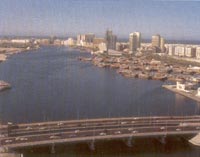
Having expanded along both
banks, Dubai’s central business district
is divided into
both Deira and Bur Dubai, which are
connected by a tunnel and two bridges.
Each has its share of fine mosques and
busy souks, of public buildings, shopping
malls, hotels, office towers, banks,
hospitals, schools, apartments and villas.
At first glance, the shoreline these days presents a predominantly
modern face; an ever-changing skyline of
new developments, from striking glass and
concrete towers to gracious modern
buildings incorporating traditional
Arabian architectural motifs and features.
The most distinctive and
remarkable buildings are ranged on the
Deira side, including the Etisalat Tower,
the Department of Economic Development,
Dubai Chamber of Commerce and Industry (DTCM),
The National Bank of Dubai headquarters
and Dubai Creek Tower.
The Etisalat Tower is topped by a telecommunications dome
resembling a giant golf ball -
particularly striking when illuminated at
night.
The Department of Economic
Development is a five-storey building
which features delicately designed window
screens and massive decorated main doors.
By contrast, the neighbouring Dubai Chamber of Commerce and
Industry tower is a dramatic blue
glass-faced structure, a symbol of the
emirate’s prosperity and forward vision.
Nearby is the municipality building, which manages to convey
an impression of cool shade through the
use of water and screens.
The new headquarters of the National Bank of Dubai produces a
shimmering reflection of the Creek through
its striking use of polished steel and
glass. This is also the DTCM’s head office
in Dubai.
But scratch the surface and
underneath the visitor will find an area
that still has its roots firmly set in a
traditional past.
The best way to view the Creek and the
dhows is from an abra, one of the small
water taxis which criss-cross the Creek
from the souks of Deira to those on the
Bur Dubai side.
A crossing costs just 50fls but for around Dhs50, the boat is
yours’ for an hour and boatmen take
visitors on a fascinating trip from the
abra embarkation points to the mouth of
the Creek and inland to the Maktoum
Bridge, passing on the way many of the
city’s historic and modern landmarks.
Rashid
Mohammed has been taking travellers across
the Creek on his abra for the last 14
years.
“It is always a good way to
travel,” said the 42 year-old: “Even with
the modern roads and bridges, people still
like to travel across on the abra. It is
quicker because the roads are so busy now.
I work 12 hours every day and it is busy
all the time. Dubai is busier now with
tourists and they keep us all busy too.”
The souks on both sides of the Creek are
attractive not just for their shopping
bargains but also as places for the
sightseer and photographer.
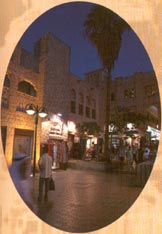 A huddle of narrow alleyways has survived
on the Deira side despite the intensive
building in recent years. In the tiny
lanes of the spice souk, the atmosphere
and the scents of the past can be savoured.
Bags of spices, incense, rose petals and
traditional medicinal products are stacked
outside each stall.
A huddle of narrow alleyways has survived
on the Deira side despite the intensive
building in recent years. In the tiny
lanes of the spice souk, the atmosphere
and the scents of the past can be savoured.
Bags of spices, incense, rose petals and
traditional medicinal products are stacked
outside each stall.
Along the slightly larger lanes of the gold souk further inland,
each shop window is crammed with gold
necklaces, rings, bangles, earrings and
brooches. In the evening the area is a
hive of activity. Gold prices are among
the lowest in the world.
In other small streets,
shops sell nargilehs (hookah or hubble-bubble
pipes) and coffee pots, and nearby tea
stalls where both of these items are in
daily use.
There are traditional
bakeries where large flat loaves of
delicious unleavened bread are baked to
order inside a domed oven called tandoor.
Small textile shops sell veils with
decorated edges, pantaloons with
embroidered anklets, and dress lengths
with similarly embroidered necklines
reminiscent of The Arabian Nights. On the
Bur Dubai side of the Creek are lanes full
of textile shops, where a blaze of
colourful raw silks and cottons hang in
profusion in shop windows.
Needless to say, shopping has evolved with the
skyline and this is best captured in Al
Nasr Square. In the heart of Deira, the
square is dominated by Deira Tower with
its distinctive circular ‘cap’. An early
example of the effort to blend modern
architecture with the older surroundings,
Deira Tower incorporates features designed
to soften the impact of the harsh summer
climate on the occupants of shops, offices
and apartments within. The square is a
magnet for shoppers looking to capitalize
on the area’s wealth of bargains in the
many electrical and clothes shops.
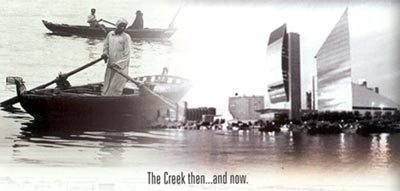
The fish souk in Deira is an attraction in
itself. Early in the morning and late at
night, local fishermen unload mountains of
fresh fish, which they sell in a frenzied
bargaining session. Kingfish, red snapper,
rock cod (the popular hammour), barracuda,
tuna, lobster, crab, king prawn, sea
bream, squid, pomfret, shark, mackerel,
sardine and other species are available in
abundance for most of the year.
Life in Dubai has been
inextricably linked with the sea. The
aridity of the desert compelled early
settlers to seek alternative occupations
and fishing rapidly developed as an
important economic activity. The birth of
a fishing industry soon led to the
development of boat building, net-making
and pearl diving and Dubai’s enterprising
traders sailed the oceans in search of
markets for their products.
Pearl divers risked life and limb to gather oysters from the
seabed, often diving for more than two
minutes at a time, with little more than a
nose-clip and a heavy stone to weight them
down. Such was the renown of Dubai’s
pearls, that pearling continued to be the
mainstay of the city’s prosperity, until
the development of the cultured pearl in
the 1940s led to the collapse in demand
for the natural variety.
The Creek was a place where the men returned home
after months at sea to be reunited with
their families and for the trading of
their catches to begin.
At Al Fahidi Fort in Bur
Dubai, which houses the Dubai Museum, a
throw back to yesteryear can be enjoyed.
It once guarded the city’s landward
approaches. Built around 1799, it has
served variously as a palace, garrison and
prison.
It was renovated in 1970 for use as a museum; further
restoration and the addition of galleries
were completed in 1995. Colourful and
evocative dioramas, complete with
life-size figures and sound and lighting
effects, vividly depict everyday life in
pre-oil days. Galleries relive scenes from
the Creek, evoking images of traditional
Arab houses, mosques, the souk, date
gardens, desert and marine life.
A
traditional heritage village is located
near the mouth of the Creek, and has been
created where potters and weavers display
their crafts. Here the visitor can look
back in time and capture the atmosphere of
Dubai before billions of dollars were
invested into its infrastructure.
The Diving Village forms part of an ambitious plan to turn
the entire Shindagha area into a cultural
microcosm, recreating life in Dubai as it
was in days gone by.
The official residence of
Sheikh Saeed Al Maktoum, Ruler of Dubai
(1912-1958) and grandfather of the present
Ruler, Sheikh Maktoum Bin Rashid Al
Maktoum, has been restored to stand proud
again and is also located in the Shindagah
end of the Creek. The house, which dates
from 1896, today houses a rare Collection
of historic photographs, coins, stamps and
documents that record Dubai’s history.
Further downstream, Al Boom
Tourist Village consists of a 2,000-seat
banquet hall, a coffee shop, restaurant,
amusement park, ornamental lake and a
marina with five cruise boats. Its
traditional architecture forms a stately
city landmark. Further development is
expected to include self-catering and
fully serviced chalets and a five-star
hotel built in the shape of a Gulf sailing
dhow.
And if all that’s not
enough, one of the world’s best golf clubs
sits opposite Creek Park and has hosted
top-class tournaments while its Marina
wouldn’t look out of place in Monaco.
Dubai may have moved on at a
breathtaking pace, but you can’t help but
feel that one foot will always remain in
history along this magical waterway.
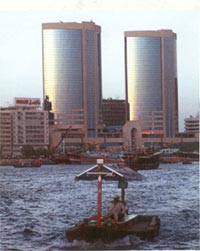 |
